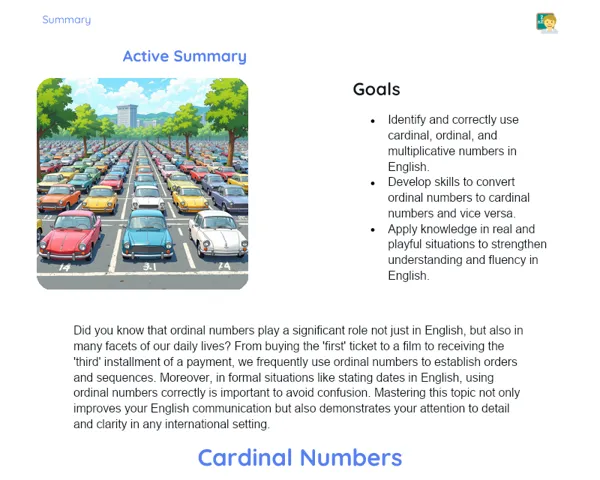Summary Tradisional | Numerals
Contextualization
Numbers form an integral part of our everyday language and are indispensable in various contexts – whether it is counting items, understanding the order in a queue, or mentioning dates and timings. In English, just as in other languages, we recognise different types of numbers, particularly cardinal and ordinal, each following its own set of rules and serving unique purposes. Grasping these differences is crucial for clear and effective communication in daily life.
Cardinal numbers, like 'one', 'two', 'three', etc., serve the purpose of indicating quantity. They are the backbone of counting and come into play often in our daily routines as well as educational settings. On the flip side, ordinal numbers such as 'first', 'second', and 'third' help in denoting the position or sequence of things—whether you are lining up for a bus or discussing dates. It is essential for students to master the art of using these numbers correctly, as it greatly aids in expressing ideas with precision.
To Remember!
Cardinal Numbers
Cardinal numbers are used when we count objects and need to state exact quantities. They form the basis of many everyday counting activities and are frequently encountered in both daily conversations and academic tasks. For example, in English, we use words such as 'one', 'two', 'three', etc., to specify numbers clearly. These numbers not only help in counting but also lay the foundation for more complex mathematical operations and day-to-day activities.
Apart from basic counting, cardinal numbers are very useful in situations like creating a shopping list, counting money, or even determining how many people attended an event. In classrooms, these numbers are of utmost importance as they help students perform simple addition and subtraction. Moreover, in scientific and technical scenarios, precise cardinal numbers are crucial – be it for recording measurements in experiments or logging data in surveys. Hence, being adept with cardinal numbers is a must for both effective communication and academic success.
-
Cardinal numbers denote exact quantities.
-
They are widely used in everyday life as well as in educational settings.
-
They form the foundation for basic computations and practical tasks.
Ordinal Numbers
Ordinal numbers tell us about the position or order of items in a sequence. They are key when describing arrangements like a queue, a ranking in a competition, or even specific dates. For instance, words like 'first', 'second', 'third' help us understand the correct sequence of events or items in a list. This logical ordering is very important, especially when information needs to be organized or when precise sequencing is necessary.
In everyday situations, ordinal numbers are indispensable. They are used, for example, when explaining the order of entry in a line, the position of a racer, or the schedule of events in a meeting. In academic and professional environments, clear ordering can be critical, and ordinal numbers assist in ensuring that information is accurately conveyed.
Additionally, when talking about historical events or planning dates, using ordinal numbers correctly ensures clarity. Understanding and employing ordinal numbers well is therefore an essential skill for clear communication.
-
Ordinal numbers show the position or order in a sequence.
-
They are often used to describe queues, competitions, and dates.
-
They help in logically organising and presenting sequential information.
Conversion of Ordinal to Cardinal Numbers
Converting ordinal numbers to their cardinal counterparts essentially involves removing the ordinal suffix to yield the cardinal form. For example, turning 'first' into 'one' involves dropping the '-st' ending. This conversion skill is fundamental in ensuring that we correctly understand and use these numbers in different contexts.
The ability to convert ordinals to cardinals is practical in everyday scenarios, like when you need to translate a race’s finishing positions into absolute numbers, or when you want to give a precise count of occurrences in a situation. In classrooms, this skill is especially useful for solving problems that involve switching between the two forms to simplify calculations or comprehend texts better.
Furthermore, mastering this conversion is invaluable when dealing with translations or complex texts, where precise number representation can make a significant difference. Overall, being able to convert ordinal numbers into cardinals enhances one's numerical fluency and overall command of the language.
-
It involves removing the ordinal suffix to reveal the corresponding cardinal number.
-
Essential for translating positions into exact numerical values.
-
Very useful both in education and in refining textual translations.
Practical Use of Numbers
Using cardinal and ordinal numbers practically is key to bridging the gap between theoretical knowledge and everyday application. Cardinal numbers help us count objects, signify precise quantities, and execute basic mathematical operations. For instance, when shopping, you might list items or count the money received using cardinal numbers.
Ordinal numbers, by contrast, are invaluable when expressing order. They help describe the sequence of events, such as the order in which people arrive at a bus stop, or the ranking of players in a tournament. This becomes crucial in planning your daily schedule or organising an event where the order of activities matters.
Encouraging students to apply these concepts in real-life scenarios, like counting the number of pages read in a book or noting the order of names in a list, truly enhances their understanding. Engaging practice sessions and interactive activities not only reinforce these concepts but also build students' confidence in using numbers effectively in various contexts.
-
Cardinal numbers are used to signify counts and specific quantities.
-
Ordinal numbers help in describing order or sequence.
-
Regular practice in everyday scenarios strengthens understanding and application.
Key Terms
-
Cardinal Numbers: Numbers that indicate specific quantities, such as 'one', 'two', 'three'.
-
Ordinal Numbers: Numbers that denote the position or order within a sequence, like 'first', 'second', 'third'.
-
Number Conversion: The technique of converting ordinal numbers to cardinals by removing the ordinal suffix.
-
Practical Use: The real-life application of both cardinal and ordinal numbers in academic and daily contexts.
Important Conclusions
In summary, this lesson shed light on the significance of cardinal and ordinal numbers in English by explaining their functions and everyday applications. Cardinal numbers help in counting and expressing exact quantities, while ordinal numbers are all about indicating order or position in a sequence. Knowing the difference is key for clear and precise communication in a myriad of situations.
We also discussed the process of converting ordinal numbers into cardinal ones, an essential skill in ensuring clarity in number representation – this is particularly important in educational settings and while translating texts. Regular practice of this conversion reinforces understanding and application.
Lastly, the practical implementation of these concepts, whether it is counting everyday items or describing sequential events, is vital to mastering the use of numbers. It is important that students engage in frequent practice to build confidence and proficiency in working with both cardinal and ordinal numbers.
Study Tips
-
Review various examples of cardinal and ordinal numbers and try composing your own sentences using them in different contexts.
-
Practice converting ordinal numbers to cardinals and vice versa to deepen your understanding.
-
Supplement your learning with language apps and educational videos on the use of numbers in English.



